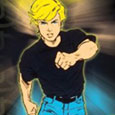Hanna-Barbera (1964), Warner Home Video (May 11, 2004), 4 discs, 659 mins plus supplements, 1.33:1 original full frame ratio, Dolby Digital 1.0 Mono, Rated G, Retail: $39.98
Storyboard:
A boy adventurer travels the world with his scientist father, investigating various unexplained phenomena. They are joined by their bodyguard Race Bannon, a boy from India with mystical powers named Hadji, and the dog Bandit.
The Sweatbox Review:
It is easy to forget now just how innovative Jonny Quest was. Back in 1964, there had only been three previous animated prime-time shows— Hanna-Barbera’s The Flintstones, Top Cat, and The Jetsons. Those first three shows were done for laughs, telling humorous stories using “cartoony” artwork. The Adventures Of Jonny Quest was another thing entirely. Jonny introduced serious adventure into prime-time animation. Even now, with all the adventure and superhero cartoons that have come and gone since 1964, how many have appeared in the evening hours?
Of course, being the “first” and being the “best” are not necessarily the same thing. This is a case, however, where it is so. After viewing the new DVD set from Warner Brothers Home Video, I am pleased to say that all these years later, Jonny Quest still stands tall as a fantastic series, regardless of its place in history.
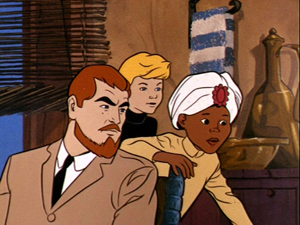
Joe Barbera wanted to do an action-adventure cartoon after seeing the first James Bond movie (Dr. No), but cartoonist Doug Wildey is generally given most of the credit for designing Jonny Quest. Wildey (1922-1994) was a terrific artist who had an intensely creative imagination and a large collection of Popular Mechanics magazines from which to draw inspiration. When the show premiered one night in September 1964 on ABC, viewers were treated to a relatively realistic show that had danger, science, and suspense. The look of the show was heavily influenced by the drawings of Wildey, who himself was heavily influenced by Milt Caniff (creator of the comic strip Terry And The Pirates). Unlike other cartoons of the time, Jonny Quest had dramatic lighting and solid blacks within the characters and backgrounds, as well as realistically proportioned people.
Young Jonny was the focus— the son of scientist Dr. Benton Quest, who took on freelance assignments for the U.S. government. Dr. Quest was a huge asset to the government, but in a sense Quest’s family was considered a liability, since they were vulnerable. After Mrs. Quest died, the government assigned a bodyguard and tutor to Jonny. The man who filled that role was Roger C. “Race” Bannon, who had already led a somewhat adventurous life as a government operative. The show was not all serious business, however, having a few lighter moments that usually involved Jonny’s bulldog, Bandit. Jonny also had a sort of adoptive brother, an Indian youth named Hadji, who had command of mystic abilities (this was one small concession to the fantastic in a series that otherwise tended to debunk paranormal phenomena). The Quest team operated out of a base on Palm Key Island, off the coast of Florida. Episodes generally involved the Quest team being sent on a scientific errand, dodging criminals intent on stealing secret inventions, or encountering exotic dangers or paranormal phenomena.

Those who track trends in media may see The Adventures Of Jonny Quest as being a precedent for X-Files, but the show itself had its own influential precursors. The tradition of the boy hero had already been established in many book series (Hardy Boys, Tom Swift, etc.), and the series was originally conceived as an adaptation of the radio show Jack Armstrong, The All-American Boy— the end-titles even feature animation from the aborted Armstrong pilot. The television animal sidekick had also been established previously, such as in Supercar, where the boy character had a pet monkey (a monkey was also Wildey’s initial plan for Jonny’s pet). The mixture of science, travel, technology, and adventure, as well as a military presence, had already been seen in the various early Supermarionation series from the UK; and the Carl Barks Disney comics sometimes had a similar combination of travel mixed with intrigue. Jonny Quest, though, had a special blend of ideas that made it unique.
The medium of animation opened up all new possibilities, allowing stories that were difficult or impossible to do as live action or puppet shows. The characters on the show traveled all over the world, investigating mysteries and foiling superspies. The show had a science fiction bent that allowed all sorts of high-tech gadgets, vehicles, and weapons. Things rarely went too far, however, and the technological devices stayed within the realm of what might be possible in the near future, largely due to the fact that they were often inspired by inventions that were being worked on in 1964. The stories were even— I dare say— educational, in a similar way that Barks’ comic books were, introducing new locales and scientific principles to viewers in the course of a story.

As the show came out before stronger network self-censorship, Jonny Quest was notable for its level of violence. Villains often die, and no one seems to feel too bad about it. Even the boys dish out a fair bit of punishment. The strong tone of this show, which is supposedly about a boy hero, is made more palatable by the fact that in many ways it is really Dr. Quest who is the protagonist. It is he who the plot usually revolves around, and the boys frequently fade into the background while Dr. Quest and Race take care of business. Both these men were well-rounded characters in their own right; Dr. Quest was brilliant but down-to-earth and resourceful, while Race provided plenty of cunning along with his muscle. Jonny and Hadji do get plenty of screen-time, however, and are essential to every plot.
Tim Matheson provided Jonny’s voice, and there were contributions from some Hanna-Barbera stalwarts as well. Don Messick, who gave voice later to Scooby-Doo, did most of Dr. Quest’s appearances, as well as the voice of bandit. John Stephenson did Dr. Quest five times, and is also known as the voice of Mr. Slate on The Flintstones. Also, listen from Henry “Fred Flintstone” Corden to pop up, such as when he played the Australian riverboat captain in Turu the Terrible.
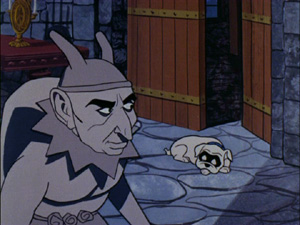
The original incarnation of Jonny Quest ran for one year, before cost overruns forced its cancellation. Despite its popularity, its large budget could not allow the show to continue. Compared to other Hanna-Barbera shows, Jonny Quest cost about 40% more to produce, dooming it to what seemed to be a brief but bright life. Fortunately, the show continued its popularity, and reached generations of new viewers, by being shown on Saturday mornings on CBS (1967) and NBC (1978). It was also syndicated, being added to the Funtastic World Of Hanna-Barbera block in the 1980’s.
Two more series starring Jonny came later. 1987 saw 13 new episodes being produced (as The New Adventures Of Jonny Quest), and added to the original 26 for Funtastic syndication. The new episodes used similar character designs, but still can easily be distinguished visually by the less illustrative look of the show. New Adventures looks more like your standard cartoon show, with easier-to-animate designs and less emphasis on the “comic strip” look the original show was known for. The newer stories also had a more fantastic slant, bringing in more blatant science fiction aspects such as time travel, as well as introducing a rock man (“Hardrock”) to the cast. Fans of the show knew it was not quite the same, but nevertheless it was good to see new adventures.
A larger departure was seen in 1996-97’s Jonny Quest: The Real Adventures . This version aged Jonny and Hadji a few years (and made them hunkier), added Race’s teenage daughter Jessie to the cast, and blended CGI with the traditional animation. It even had a virtual reality world that the kids often visited. The show has its detractors, not helped by the fact that there were two distinct versions of the show. “Season One” was animated by several different animation houses, while “Season Two” had one animation provider. Each season has different character models and different voice actors. The changes were reportedly made due to shortcomings in the original production staff, which necessitated their firing after three years of producing “unairable material”. Four new producers were hired, two of which used the already-existing designs, and two of which did other designs based more on the old show. The two versions were initially planned to be launched separately, but all 52 shows ended up being thrown together, resulting in confusion for viewers.
There were also two TV movies. Jonny’s Golden Quest flashed back to Jonny’s mom, and was basically part of the 1980’s version (this was also where Jessie was first introduced). Jonny Quest Vs. The Cyber Insects bridged the gap between the original and Real versions, and was advertised as the last appearance of the original Jonny Quest.
By the way, do not try to tie all the series and movies together too strongly. The TV movies are not considered part of “official continuity” as far as the Real version is concerned, and many similarly disavow the 1986 version. There are several inconsistencies, especially where the mothers of Jonny and Jessie are concerned. Nevertheless, I find something to enjoy in each of them, and look forward to future DVD releases (hopefully).
The discs under consideration here are part of that wonderful new line from Warner Brothers, the “Hanna Barbera Golden Collection”. The four discs in this set comprise all 26 of the original “Classic” Jonny Quest episodes. More than any of the versions that followed, this Jonny Quest sticks to the concept created by Doug Wildey. Classic Jonny is grounded in the real world, with believable science and tangible peril. The limited animation Hanna-Barbera is known for only means that the fine draftsmanship in the show can be better appreciated. The episodes generally follow the action-adventure vein, but also lapse into mystery and horror. Here is a quick rundown of the episodes, with some brief comments. Each episode has only a single chapter.

Disc One
Mystery Of The Lizard Men – A mystery involving missing ships brings the group to the Sargasso Sea to face laser guns and “lizard men”.
Arctic Splashdown – A deflected missile lands in the frozen wasteland, and the race is on to recover it.
The Curse Of Anubis – An Arab chieftain lures the Quest team to Egypt to use them in a plot to unite his people and become their leader. Before the story ends, a mummy will walk again.
Pursuit Of The Po-Ho – Dr. Quest goes into the jungle to save a friend kidnapped by natives, and finds himself captured.
Riddle Of The Gold – This tale has a trip to India and the first appearance of Quest nemesis Dr. Zin, in a story involving a process to create gold.
Treasure Of The Temple – An ancient Mayan city holds the promise of a lost treasure.
Calcutta Adventure – This flashback episode is the “origin” of how Hadji joined the Quest team.
Disc Two
The Robot Spy – In perhaps the series’ most popular episode, Dr. Zin uses an arachnid-like robot to gain the secret of Dr. Quest’s new ray gun.
Double Danger – Dr. Zin and Dr. Quest compete to find a rare plant in Thailand. Race’s old flame, Jezebel Jade, also arrives on the scene to help determine that Race is not who he appears be. This was actually the first episode produced, which explains its weaker animation. One can tell that the Hanna-Barbera animators initially struggled with the more realistic drawing style. Despite improving greatly over the next few episodes, this awkwardness would show up again years later in Super Friends.
Shadow Of The Condor – A forced landing in the Andes leads to a meeting with a baron who flew in World War I , and his mute servant. A conflict is decided in an air duel.
Skull And Double-Crossbones – Modern-day pirates overpower a Quest expedition and force Jonny to dive for treasure.
The Dreadful Doll – Voodoo and a secret submarine base figure into this mystery.
A Small Matter Of Pygmies – Another forced landing, this time in a jungle, finds the group chased by pygmies.
The Dragons Of Ashida – An insane zoologist and his giant reptiles trap the Quest team on a small island.

Disc Three
Turu The Terrible – A search for a special metal leads instead to the discovery of a flying dinosaur controlled by a wheelchair-bound schemer.
The Fraudulent Volcano – Dr. Quest unintentionally comes into conflict with Dr. Zin, who is using a volcano as a testing ground for a new weapon.
The Werewolf Of The Timberland – French-Canadians and a wolfman figure in this mystery of smuggled gold.
Pirates From Below – Criminals attempt to steal another of Dr. Quest’s inventions.
Attack Of The Tree People – The boys and Bandit survive a boat fire and come ashore an island, then require the assistance of apes to thwart some would-be kidnappers.
The Invisible Monster – A colleague of Dr. Quest disappears after accidentally creating an energy creature.
The Devil’s Tower – You just cannot beat an episode with a mile-high mountain, Nazis, and aborigines who speak German.
Disc Four
The Quetong Missile Mystery – Poisoned swamp fish, a General Fong, and a secret missile enter into this story.
The House Of Seven Gargoyles – Gravity reversal, a dwarf, a submarine, and a glacier— this is a shopping list for a typically exciting Jonny Quest episode.
Terror Island – Dr. Quest is kidnapped in Hong Kong, and Race must ask Jade for help in locating him.
Monster In The Monastery – Jonny meets monks in Nepal threatened by Abominable Snowmen.
The Sea Haunt – A sea monster seems to have a taste for treasure.
Is This Thing Loaded?
The menus feature some brief animation that cannot be skipped, including a montage of scenes before settling into a Main Menu console. You may choose to play all episodes on the disc, or go to an Episode Menu. The Episode Menu is a console close-up with a circular view screen that shows an image of the selected show— pretty slick.

All of the Special Features may be found on Disc Four. Jonny Quest Files: Fun Facts, And Trivia (25:18) re-presents Double Danger (which was actually the first produced episode), with pop-up trivia. The trivia examines many aspects of the show, Doug Wildey, voice talent, and merchandising. This is informative, and nicely takes the place of a “making of…” featurette.
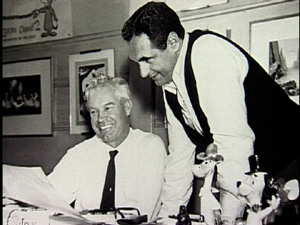
There is still one good featurette, however, in the form of Jonny Quest: Adventures In Animation (15:14). Through interviews with animation people such as Dan Riba and Brad Bird, and comic book artists Alex Ross and Steve Rude, the historical noteworthiness of the series is discussed. Anyone not convinced yet of the significance of the show will gain a better appreciation after seeing this nifty featurette.
Jonny Quest Video Handbook has ten entries which run one to three minutes in length, each discussing either a character or aspect of the show. It is a little fluffy, but worth watching once. Then, there is a vintage P.F. Flyer Commercial, showing how Jonny and Race used to sell running shoes back in the day when the show first aired.
Lastly, there is some advertising, including trailers for the Flintstones, Scooby-Doo, Jetsons, and Samurai Jack sets.
Case Study:
Similar to the other early entries in the “Hanna Barbera Golden Collection”, the Jonny Quest discs come in a foldout digipack encased in a transparent plastic slipcase. The effect of the slipcase art over the cardboard digipack simulates the look of an animation cel, and looks pretty slick. The red and orange-themed digipack is nicely designed, with disc contents listed alongside series trivia and scenes from the show. This all looks very sharp, and gives Jonny the presentation he deserves.
Ink And Paint:
What strikes me most about the show visually is the economy of the animation. Yes, it is “limited” in many ways, but in Jonny Quest it seems that the best animation was simply being saved for where it could be used to greatest effect. There are moments here and there where a little something extra is added which would not be seen in many cartoons; and while quiet moments may not be fully animated, a big action sequence may feature all sorts of explosions, debris, and character movement. It is true to the idea of a “comic strip come to life”, with dialog being read by largely static characters that can suddenly spring to life when the moment calls for it.

As far as the actual video, it is naturally in the traditional 4:3 television ratio, as originally broadcast. The show looks much like it should, given its age and its production history. There is the requisite amount of cel dust and general specks in the picture, but this is likely as good as the show ever looked. The compression work is quite good, with no major issues noted. The image looked quite good on my 32” set, but on my 51” set, it was noticeably soft.
Scratch Tracks:
The audio has a nice amount of “pop” for a forty-year old mono soundtrack! Befitting an action-adventure show, the explosions and gunfire get one’s attention, and the sound is as crisp as one would like. The funniest thing that I noticed in the soundtrack was the recycled music from other Hanna-Barbera programs— it is just weird to hear Flintstones themes played during a show of such a distinctly different nature!
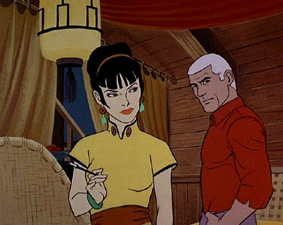
Hoyt Curtin’s score for the opening and closing, though, still absolutely rocks!! This may be the best cartoon theme ever. As soon as you hear that music at the beginning of the episode, it sets the mood for what is to come— thrills and adventure!
Languages include English and Spanish, while subtitles are provided in English, Spanish, and French.
Final Cut:
This is simply one of the great cartoon shows, significant for its place in history as well as its high quality. This complete set of the original show is a dream come true for those of us who have tried to track down what we could on laserdisc and old videotapes. The video and audio are as good as one could hope, and the special features are the strongest yet assembled for the Hanna-Barbera sets. This collection is highly recommended!
 | ||
 |








